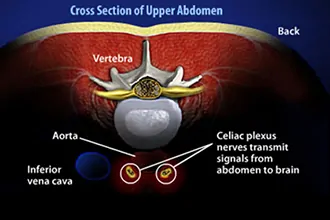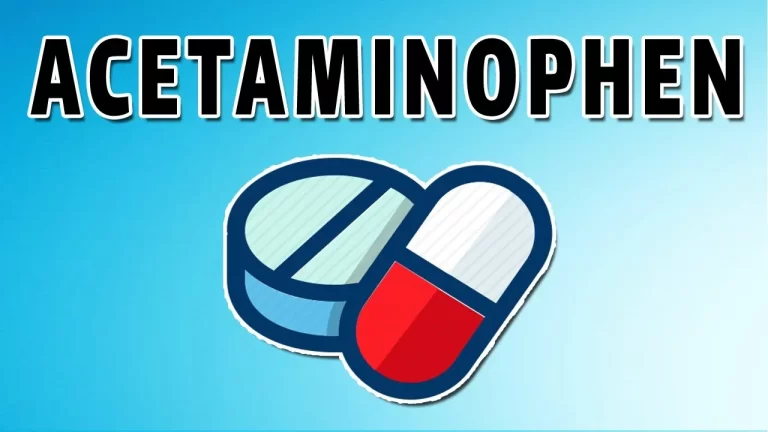Celiac Plexus Block
What is Celiac Plexus Block?
A celiac plexus block is a pain-ease therapy delivered by injection. The therapy controls celiac plexus nerves from sending pain messages to the brain. It’s a variety of nerve blocks. Healthcare providers or doctors use celiac plexus blocks to treat a patient who has pancreatic cancer or chronic pancreatitis. These illnesses can cause extreme abdominal pain.
What is the celiac plexus?
The celiac plexus is a portion of the nervous system. This bundle of nerves in the upper abdomen sits after the pancreas near the aorta, the body’s biggest blood vessel.
Celiac plexus nerves transmit signals to the brain and spinal cord from digestive system organs, involving the:
- Gallbladder.
- Intestines.
- Liver.
- Pancreas.
- Stomach.
Purpose of a celiac plexus block
A celiac plexus block is conducted to block the celiac plexus of nerves that go to different organs and regions of the abdomen. This may in turn decrease pain in the abdomen. It is done as a part of the therapy for Chronic Pancreatitis and other kinds of Chronic Abdominal Pain.
Benefits of a celiac plexus block
A patient who has pancreatic cancer or pancreatitis may require a celiac plexus block to manage severe abdominal pain. Approximately 3 out of 4 patients have notable abdominal pain at the time they obtain a pancreatic cancer diagnosis. Yet, this pain involves 9 out of 10 patients.
Healthcare providers or doctors generally prescribe strong pain drugs to control this pain. But these drugs can cause uncomfortable side effects such as constipation, confusion, and nausea. With a celiac plexus block, you may be capable to decrease the drug dose or quantity.
Even with drugs, more than half of patients still have pain. Periods of extreme pain, known as breakthrough pain, can happen. A celiac plexus block can reduce the frequency of breakthrough aches.
How is the celiac plexus block performed?
Indications
Intractable abdominal pain
Frequently from upper abdominal malignancy: gastric, pancreatic, esophageal, metastatic liver, and retroperitoneal lymphadenopathy
Chronic pancreatitis
Extreme nausea and vomiting in pancreatic malignancy
Contraindications
Uncontrolled abdominal infection or sepsis
Uncorrectable bleeding diathesis
Bowel obstruction
Preparation for Celiac Plexus Block
Pre-procedure preparation for a celiac plexus block will include the subsequent steps:
A comprehensive analysis is conducted by your doctor or physician to study for any medical problems that require to be addressed before the method.
Relying on your social history, medical record, and age, you may require to undergo tests like blood work and imaging to assist to notice any abnormalities that could threaten the security of the method.
You will be asked if you have allergies to anesthesia, drugs, or latex.
You should inform your doctor or physician of any vitamins, drugs, or supplements that you are assuming.
You may require to refrain from vitamins and supplements or drugs like blood thinners for a week or two before the process.
You should refrain from alcohol or tobacco at least a few days before the process.
You should not consume any solids or liquids at least 8 hours before the procedure.
Refrain from wearing any lotions or makeup and metallic things like a watch, jewelry, piercings, and so on.
You should organize for someone to drive you home after the process.
Written permission will be received from you after the process has been described in detail.
Procedure for Celiac Plexus Block
Celiac plexus block is a minimally invasive percutaneous (via the skin) process that brings approximately an hour and you may go home on the same day. In general, the process includes the next steps:
You will lie on your stomach in a prone position on an X-ray table.
The intravenous drug is administered to calm you.
Your physician or doctor will then administer a local anesthetic to numb the site of the skin on your back accepting the injection.
Under X-ray advice, your physician or doctor will conduct the following:
Defines specifically where the celiac plexus is found for subsequent injection
Puts a fine syringe into the back solely adjacent to the spine and injects anesthetic after the target is set
Injects a second syringe on the different side of the spine to administer a dye into the body to verify that the proper site is being targeted
Verifies that the second syringe is in the right spot and administers pain drugs like epinephrine or steroid to numb the nerves in the region. Phenol or alcohol may also be used to eliminate the nerves.
The syringe is withdrawn, and a bandage is used at the therapy site.
Post-Procedural Care and Recovery
In general, post-procedural care instructions and healing after celiac plexus block will include the next steps:
You will be moved to the recovery room where your nurse will closely monitor you for any allergic/anesthetic responses and observe you’re vital signs.
You may sense drowsy, nauseous, and a warm and full feeling in your stomach. Drugs are delivered as required to address these symptoms.
You may experience inflammation, pain, and discomfort at the therapy site. Pain and anti-inflammatory drugs are prescribed as required.
You will be capable of the shower the very following day of the process.
You may experience watery or loose bowel motions for a few days.
Refrain from using heavy machinery or driving for at least 24 hours.
Refrain from ingesting alcohol for at least 24 hours.
You will be capable to continue your regular activities within a couple of days but may have specific activity limitations.
A follow-up visit will be planned to observe your progress.
What are the potential risks or complications of a celiac plexus block?
Common risks of celiac plexus block include:
- Bruising or soreness in the injection area
- Tenderness, Pain, and swelling in the injection area
- Low blood pressure
- Diarrhea
- Muscle spasm at the injection area
Further less common but possible side effects contain:
- Delayed gastric emptying
- Damage to kidneys
- Paralysis
- Seizures or low blood delivery to the spinal cord
- Allergic response to the dye or medication injected
- Accidental puncture of an organ
- Infection at the injection or IV area
- Collapsed lung
- Nerve damage
- Bleeding
Conclusion
The celiac plexus block is a useful therapy for the management of abdominal ache that does not need surgery. This process is particularly helpful for patients who have been assuming opioids but have not experienced effective pain relief or have attempted conventional therapies that were also useless. There are minimal risks associated with this process and some peoples experience practically immediate pain ease. Also, this nerve block can safely be replicated for people who do not react to the initial block and full pain relief may happen after repeated therapies.
FAQ
Will the celiac block hurt?
The process includes inserting a syringe via the skin and deeper tissues. So, there is some pain included. Yet, we may numb the skin and deeper tissues with a local anesthetic utilizing a very thin syringe before inserting the actual block syringe. Most people also obtain intravenous sedation which makes the process easier to tolerate.
Will I be placed out for the celiac plexus block?
This process is accomplished under local anesthesia. Most people also obtain some sedation, which makes the process easy to tolerate. The quantity of sedation offered generally depends upon the people’s tolerance. Some people may have adequate sedation that they have amnesia and may not recall all or regions of the process.
What should I hope for after the celiac plexus block?
Immediately after the injection, you may sense your abdomen bringing warmth or feeling a bit various. In extra, you may see that your abdominal ache may be gone quite often. You may also see some brief weakness or numbness in the abdominal wall or leg, although this is not a preferred outcome of a celiac plexus block.
How many celiac plexus blocks do I require to have?
If you react to the first injection, you will be suggested for recurrence injections. Generally, a series of such injections is required to manage the issue. Some may require just 2 to 4 and some may require more than 10. The reaction to such injections differs from person to person.
Will the celiac plexus block help me?
It is occasionally hard to expect if the injection will assist you or not. Persons who present early during their condition tend to react better than those who have had symptoms for a long time. Persons in the advanced phases of the condition may not react sufficiently. Dr. Allaei has conducted a numeral of these safely delivering immense pain ease for people.








One Comment